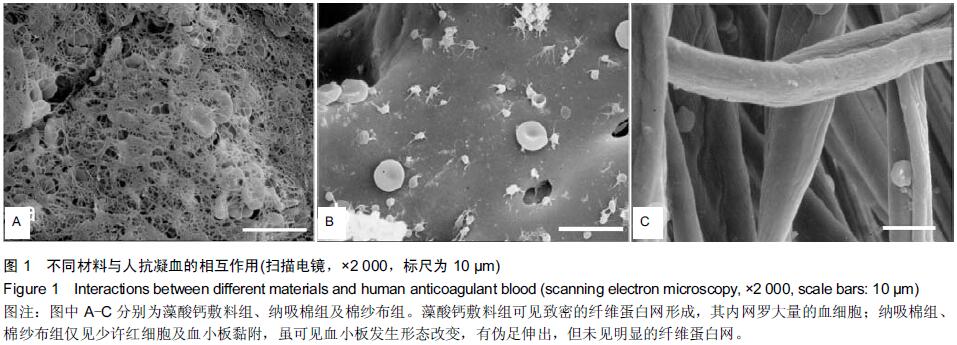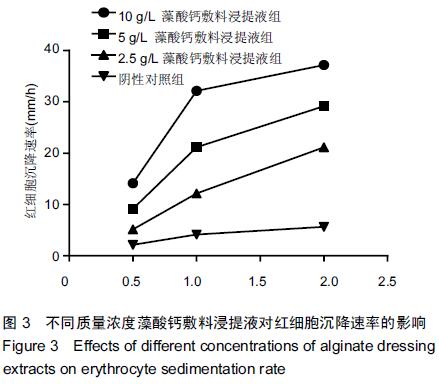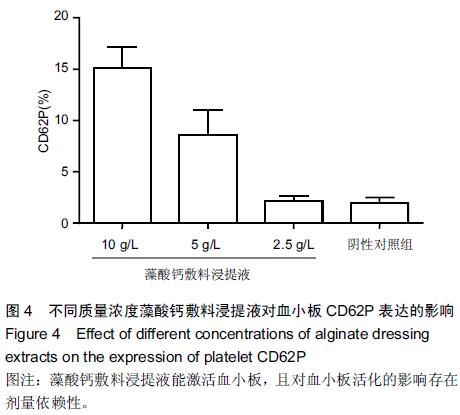Chinese Journal of Tissue Engineering Research ›› 2015, Vol. 19 ›› Issue (47): 7681-7686.doi: 10.3969/j.issn.2095-4344.2015.47.025
Previous Articles Next Articles
Hemostatic mechanism of calcium alginate dressing
Cui Fei-yan1, Wang Bin1, Wei Li2, Wang Hai-tao1, Chen Hao1, Chu Xiao-xia1, Wang Zhen-zhen1, Yang Li-hua3
- 1Department of Special Medicine, Qingdao University Medical College, Qingdao 266071, Shandong Province, China; 2the 401st Hospital of Chinese PLA, Qingdao 266071, Shandong Province, China; 3Department of Immunology, Qingdao University Medical College, Qingdao 266071, Shandong Province, China
-
Received:2015-08-29Online:2015-11-19Published:2015-11-19 -
Contact:Wang Bin, Professor, Department of Special Medicine, Qingdao University Medical College, Qingdao 266071, Shandong Province, China Wei Li, Professor, the 401st Hospital of Chinese PLA, Qingdao 266071, Shandong Province, China -
About author:Cui Fei-yan, Studying for master’s degree, Department of Special Medicine, Qingdao University Medical College, Qingdao 266071, Shandong Province, China
Cite this article
Cui Fei-yan, Wang Bin, Wei Li, Wang Hai-tao, Chen Hao, Chu Xiao-xia, Wang Zhen-zhen, Yang Li-hua. Hemostatic mechanism of calcium alginate dressing[J]. Chinese Journal of Tissue Engineering Research, 2015, 19(47): 7681-7686.
share this article
|
[1] Kauvar DS,Lefering R,Wade CE.Impact of hemorrhage on trauma outcome: an overview of epidemiology, clinical presentations, and therapeutic considerations.J Trauma. 2006;60(6 Suppl):S3-11.
[2] Cripps MW,Kutcher ME,Daley A,et al.Cause and timing of death in massively transfused trauma patients.J Trauma Acute Care Surg.2013;75(202):S255-S262.
[3] Alam HB,Burris D,DaCorta JA,et al.Hemorrhage control in the battlefield: role of new hemostatic agents.Mil Med. 2005; 170(1):63-69.
[4] 陈孝平,汪建平.外科学[M].8版.北京:人民卫生出版社,2013: 166-170.
[5] 柯林楠,冯晓明,王春仁.医用敷料研究的现状与进展[J].中国组织工程研究与临床康复,2010,14(3):521-524.
[6] Jansdown AB,Payne MJ.An evaluation of the local reaction and biodegradation of calcium sodium alginate (Kaltostat) following subcutaneous implantation in the rat.J R Coll Surg Edinb.1994;39(5):284-288.
[7] Suzuki Y,Nishimura Y,Tanihara M,et al.Evaluation of a novel alginate gel dressing:cytotoxicity to fibroblasts in vitro and foreign-body reaction in pig skin in vivo.J Biomed Mater Res.1998;39(2):317-322.
[8] Tonnesen HH,Karlsen J.Alginate in drug delivery systems. Drug Dev Ind Pharn.2002;28(6):62l-630.
[9] Oliver LC,Blaine G. Haemostasis with absorbable alginates in neurosurgical practice. Br J Surg.1950; 37(147):307-310.
[10] Sirimanna KS.Calcium alginate fibre(Kahostat 2)for nasal packing after trimming of trubinates:a pilot study.J Laryngol Otol.1989;103(11):1067-1068.
[11] Groves AR,Lawrence JC.Alginate dressing as a donor site haemostat.Ann R coll Surg Engl.1986;68(1):27-28.
[12] Kim JT,Kim YH,Kim SW.Customized negative pressure wound therapy for intractable auricular defects using alginate dressings and feeding tubes.J Plast Reconstr Aesthet Surg. 2014;67(11):e284-286.
[13] McBride CA,Kimble RM,Stockton K.Three donor site dressings in pediatric split-thickness skin grafts: study protocol for a randomised controlled trial. Trials. 2015;16(1): 557.
[14] Qin Y.The gel swelling properties of alginate fibers and their application in wound management.Polym Adv Technol. 2008; 19(1):6-14.
[15] 骆强,孙玉山.医用海藻纤维的研究[J].非织造布,2011,19(1): 30-32.
[16] Thomas S. Alginate dressings in surgery and wound management--Part 1. J Wound Care. 2000;9(2):56-60.
[17] 徐文荣,王建中.临床血液学检验[M].5版.北京:人民卫生出版社,2012:291-300.
[18] Smith CJ,Vournakis JN,Demcheva M,et al.Differential effect of materials for surface hemostasis on red blood cell morphology.Microsc Res Tech.2008;71(10):721-729.
[19] Mi chiels JJ,Berneman Z,Gadisseur A,et al. Aspirin-responsive, migraine-like transient cerebral and ocular ischemic attacks and erythromelalgia in JAK2-positive essential thrombocythemia and polycythemia vera.Acta Haematol.2015;133(1):56-63.
[20] Valeri CR,Cassidy G,Linda E,et al.Anemia-induced increase in the bleeding time: implications for treatment of nonsurgical blood loss.Transfusion.2001;41(8):977.
[21] Walker B,Towhid ST,Schmid E.Dynamic adhesion of eryptotic erythrocytes to immobilized platelets via platelet phosphatidylserine receptors.Am J Physiol Cell Physiol. 2014; 306(3):C291-297.
[22] Wang W,Diacovo TG,Chen J,et al.Simulation of platelet, thrombus and erythrocyte hydrodynamic interactions in a 3D arteriole with in vivo comparison.PLoS One. 2013;8(10): e76949.
[23] Wang L,Olivecrona G,Götberg M,et al.ADP acting on P2Y13 receptors is a negative feedback pathway for ATP release from human red blood cells.Circ Res. 2005;96(2):189-196.
[24] Goldsmith HL,Bell DN,Spain S,et al.Effect of red blood cells and their aggregates on platelets and white cells in flowing blood.Biorheology.1999;36(5-6):461-468.
[25] Gladwin MT,Crawford JH,Patel RP.The biochemistry of nitric oxide, nitrite, and hemoglobin: role in blood flow regulation. Free Radic Biol Med.2004;36(6):707-717.
[26] Smith CJ,Vournakis JN,Demcheva M,et al.Differential effect of materials for surface hemostasis on red blood cell Morphology. Microsc Res Tech.2008;71(10):721-729.
[27] Gu R,Sun W,Zhou H,et al.The performance of a fly-larva shell-derived chitosan sponge as an absorbable surgical hemostatic agent.Biomaterials.2010;31(6):1270-1277.
[28] Lewis DA,Nyska A,Potti A,et al.Hemostatic activation in a chemically induced rat model of severe hemolysis and thrombosis.Thromb Res.2006;118(6):747-753.
[29] Vahidkhah K,Diamond SL,Bagchi P.Platelet dynamics in three-dimensional simulation of whole blood.Biophys J. 2014;106(11):2529-2540.
[30] Jordan A,David T,Homer-Vanniasinkam S,et al.The effects of margination and red cell augmented platelet diffusivity on platelet adhesion in complex flow. Biorheology. 2004;41(5): 641-653.
[31] Zhao L,You G,Liao F,et al.Sodium alginate as viscosity modifier may induce aggregation of red blood cells.Artif Cells Blood Substit Immobil Biotechnol. 2010;38(5):267-276.
[32] Hori K,Miyasawa K,Ito K.Hemagglutinins in marine algae.Bull Jap Soc Soi Fish. 1981;47(6):793-798.
[33] Wu CC,Ko FN,Huang TF,et al.Mechanisms-regulated platelet spreading after initial platelet contact withcollagen Biochem Biophys Res Commun.1996;220(2):388-393.
[34] 吴鸿.血小板活化过程中的钙离子信号[J].生理科学进展, 2012, 43(6):417-421.
[35] Qin Y,Gilding DK.Alginate fibres and wound dressings.Med Dev Technol. 1996;7(9):32-41.
[36] Sweeney IR,Miraftab M,Collyer G.Absorbent alginate fibres modified with hydrolysed chitosan for wound care dressings--II. Pilot scale development. Carbohydr Polym. 2014;102:920-827.
[37] 秦益民,朱长俊,冯德明,等.海藻酸钙医用敷料与普通棉纱布的性能比较[J].纺织学报,2007,28(3):45-48.
|
| [1] | Zhang Tongtong, Wang Zhonghua, Wen Jie, Song Yuxin, Liu Lin. Application of three-dimensional printing model in surgical resection and reconstruction of cervical tumor [J]. Chinese Journal of Tissue Engineering Research, 2021, 25(9): 1335-1339. |
| [2] | Zeng Yanhua, Hao Yanlei. In vitro culture and purification of Schwann cells: a systematic review [J]. Chinese Journal of Tissue Engineering Research, 2021, 25(7): 1135-1141. |
| [3] | Xu Dongzi, Zhang Ting, Ouyang Zhaolian. The global competitive situation of cardiac tissue engineering based on patent analysis [J]. Chinese Journal of Tissue Engineering Research, 2021, 25(5): 807-812. |
| [4] | Wu Zijian, Hu Zhaoduan, Xie Youqiong, Wang Feng, Li Jia, Li Bocun, Cai Guowei, Peng Rui. Three-dimensional printing technology and bone tissue engineering research: literature metrology and visual analysis of research hotspots [J]. Chinese Journal of Tissue Engineering Research, 2021, 25(4): 564-569. |
| [5] | Chang Wenliao, Zhao Jie, Sun Xiaoliang, Wang Kun, Wu Guofeng, Zhou Jian, Li Shuxiang, Sun Han. Material selection, theoretical design and biomimetic function of artificial periosteum [J]. Chinese Journal of Tissue Engineering Research, 2021, 25(4): 600-606. |
| [6] | Liu Fei, Cui Yutao, Liu He. Advantages and problems of local antibiotic delivery system in the treatment of osteomyelitis [J]. Chinese Journal of Tissue Engineering Research, 2021, 25(4): 614-620. |
| [7] | Li Xiaozhuang, Duan Hao, Wang Weizhou, Tang Zhihong, Wang Yanghao, He Fei. Application of bone tissue engineering materials in the treatment of bone defect diseases in vivo [J]. Chinese Journal of Tissue Engineering Research, 2021, 25(4): 626-631. |
| [8] | Zhang Zhenkun, Li Zhe, Li Ya, Wang Yingying, Wang Yaping, Zhou Xinkui, Ma Shanshan, Guan Fangxia. Application of alginate based hydrogels/dressings in wound healing: sustained, dynamic and sequential release [J]. Chinese Journal of Tissue Engineering Research, 2021, 25(4): 638-643. |
| [9] | Chen Jiana, Qiu Yanling, Nie Minhai, Liu Xuqian. Tissue engineering scaffolds in repairing oral and maxillofacial soft tissue defects [J]. Chinese Journal of Tissue Engineering Research, 2021, 25(4): 644-650. |
| [10] | Xing Hao, Zhang Yonghong, Wang Dong. Advantages and disadvantages of repairing large-segment bone defect [J]. Chinese Journal of Tissue Engineering Research, 2021, 25(3): 426-430. |
| [11] | Chen Siqi, Xian Debin, Xu Rongsheng, Qin Zhongjie, Zhang Lei, Xia Delin. Effects of bone marrow mesenchymal stem cells and human umbilical vein endothelial cells combined with hydroxyapatite-tricalcium phosphate scaffolds on early angiogenesis in skull defect repair in rats [J]. Chinese Journal of Tissue Engineering Research, 2021, 25(22): 3458-3465. |
| [12] | Wang Hao, Chen Mingxue, Li Junkang, Luo Xujiang, Peng Liqing, Li Huo, Huang Bo, Tian Guangzhao, Liu Shuyun, Sui Xiang, Huang Jingxiang, Guo Quanyi, Lu Xiaobo. Decellularized porcine skin matrix for tissue-engineered meniscus scaffold [J]. Chinese Journal of Tissue Engineering Research, 2021, 25(22): 3473-3478. |
| [13] | Mo Jianling, He Shaoru, Feng Bowen, Jian Minqiao, Zhang Xiaohui, Liu Caisheng, Liang Yijing, Liu Yumei, Chen Liang, Zhou Haiyu, Liu Yanhui. Forming prevascularized cell sheets and the expression of angiogenesis-related factors [J]. Chinese Journal of Tissue Engineering Research, 2021, 25(22): 3479-3486. |
| [14] | Liu Chang, Li Datong, Liu Yuan, Kong Lingbo, Guo Rui, Yang Lixue, Hao Dingjun, He Baorong. Poor efficacy after vertebral augmentation surgery of acute symptomatic thoracolumbar osteoporotic compression fracture: relationship with bone cement, bone mineral density, and adjacent fractures [J]. Chinese Journal of Tissue Engineering Research, 2021, 25(22): 3510-3516. |
| [15] | Liu Liyong, Zhou Lei. Research and development status and development trend of hydrogel in tissue engineering based on patent information [J]. Chinese Journal of Tissue Engineering Research, 2021, 25(22): 3527-3533. |
| Viewed | ||||||
|
Full text |
|
|||||
|
Abstract |
|
|||||









